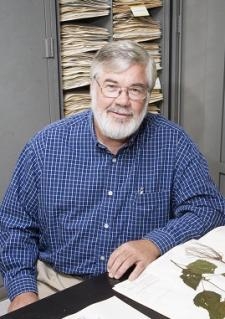Education:
- Ph.D., Duke University
- Postdoctoral, University of Arizona and Harvard University
We have a critical need to understand species concepts and the process of speciation. The importance of this need was best explained by Aldo Leopold, the 20th century conservationist who stated that the "key to intelligent tinkering is to save all the parts." As we "tinker" with our environment through climate change and habitat fragmentation, we need to have a good inventory of the world's species and how these species interact in their communities.
My research is focused on three aspects of the species issue: 1) species boundaries, phylogeography and systematics, 2) floristics and 3) biodiversity informatics. Many graduate and undergraduate students have worked with me on various aspects of these projects. Below I describe the three aspects of my research.
My exploration of species boundaries and the process of speciation has focused on three groups: 1) the Virginia Spiraea, 2) the genus Hexastylis, or "little brown jugs" and 3) dogwoods or the genus Cornus. We have explored the Federally Threatened Virginia Spiraea using various markers, such as RAPDs and ISSRs, and also three chloroplast genes, in order to compare populations within and between the drainages that encompass the distribution of this species (Tennessee, Cumberland and Ohio Rivers). We have recently shown, using two chloroplast markers, that the genus Hexastylis is monophyletic, contrary to earlier ITS data generated by Kelly. We are currently embarking on a microsatellite analysis of the Federally Threatened H. naniflora, or the dwarf flowered heartleaf, that should provide good data to help understand evolutionary relationships in this group. My work with the dogwoods has been ongoing from my dissertation work. This group has about 50 species, with the most diversity in eastern North America and eastern Asia. We are currently describing the North American dogwoods for the Flora of North America treatment and I hope to be able to apply some molecular tools to our analysis of relationships in this group.
Floristic studies are the first step in understanding the plants of areas that vary in size from a thousand to tens of thousands of hectares. Our efforts have focused on the "High Peaks" region of northwest North Carolina. This area is of particular interest because of the underlying amphibolite rocks that make the soil more basic than typical soils in the Southern Appalachians. We have conducted floristic studies on Mt. Jefferson, Tater Hill and Three Top Mountain, and we ultimately plan to examine all the major peaks in the region. The data we generate through these studies will be used to help understand the biogeography of the Southern Appalachian Mountains, an area that is being rapidly developed and in need of extensive conservation effort.
My focus on biodiversity informatics stems from my efforts over the past five years to develop the SouthEast Regional Network of Expertise and Collections (SERNEC; see http://www.sernec.org/). In general, we are trying to take herbarium specimens (dried plant material, affixed to paper, and labeled with species and habitat information) and make the information they contain available to the greater scientific community. These data include images of the specimens, along with the label data that includes habitat and phenological information. Although many herbaria (plant museums) have been digitizing their collections, the real power of this effort will come when we can mobilize many collections across the region and nation. I am co-chair of a national effort to organize herbaria in order to exchange information and develop community "best practices" so the data can be easily compiled and compared. This group, the US Virtual Herbarium (see http://usvirtualherbarium.org/), is working to provide integrated access to plant data from herbaria and museums in the United States of America.
My latest effort to organize the museum community has been the development of a proposal to the National Science Foundation to extend the SERNEC effort to an "all-taxa" project. If this project is funded, we will work with partners (state Natural Heritage Programs and NatureServ) to use our museum data to explore ways to use these data in environmental planning, where the data can be used in various city, county, state and federal levels of strategic planning for habitat preservation, buffer and corridor acquisition and environmentally sound development plans. This partnership will allow us to make a connection with ongoing efforts to quantify the value of life to society, the study of ecosystem services, and will bring me, full circle, to use my exploration of species and speciation, to "save all the pieces" and to develop new ways to put these pieces together in our rapidly changing world.
In addition to these research interests, while teaching plant systematics in various field and laboratory settings, I have developed a textbook over the past five years entitled "Vascular Plant Taxonomy." This is part of my broader effort to explore various methods to reach people of different ages and experiences, to help them explore the diverse biota and the resources (museums and herbaria) to assist in this effort. This work has involved the use of multiple forms of media, from textbooks to websites, to examine ways to spark people's interest and facilitate their exploration of the diverse life forms we have found, and continue to find, on Earth.
Selected Publications:
- Murrell, Z.E. (1994) Dwarf dogwoods: intermediacy and the morphological landscape. Systematic Botany 19: 539-556.
- Murrell, Z.E. (1996) Cornus in South and Central America: A new subgeneric classification. Systematic Botany 21(3): 273-288.
- Hardin, J.W., and Murrell, Z.E. (1997) Leaf surface structures and evolutionary relationships in the genus Cornus. Journal of the Torrey Botanical Society 124: 124-139.
- Murrell, Z.E. (1999) What is the function of an herbarium in a Department of Biology at colleges and comprehensive universities? ASB Bulletin.45(4):194-199.
- Anders, C.M., and Murrell, Z.E. (2001) Morphological, molecular, and biogeographical variation within the imperiled Virginia Spiraea. Castanea 66:24-41.

Title: Professor , Plant Systematist
Department: Department of Biology
Email address: Email me
Phone: (828) 262-2674